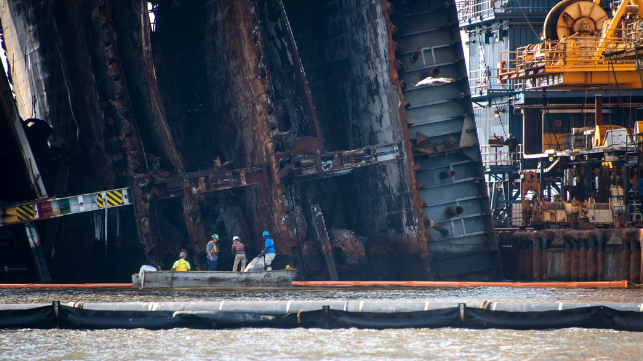Video: Salvors Complete Final Cut of Golden Ray Wreck Removal Project

On Saturday, salvors completed the very last cut in the long-running Golden Ray wreck removal project. All that remains is to load out the last two segments of the hull and clean up the seabed, and the waters of St. Simons Sound, Georgia will have the same appearance as before the vessel's grounding.
The team finished cutting the last of the Golden Ray's wreck into two sections on Saturday and are now getting ready to lift and stow one of the last two segments onto a dry-dock barge. Once that process is complete, the final segment will be loaded and stowed on the deck barge Julie B. An extra dry-dock barge is still on site in case it is needed for the last segment.
The unified command has not reported any large-scale fuel oil spillage during this cutting evolution, but responders are still on hand in case another release should occur. During a previous cutting and hoisting operation in late July, an exensive bunker fuel spill prompted a public health warning and a large-scale shoreline cleanup effort involving about 80 responders.
The wreck removal project has taken far longer than initially expected. Salvors' early projections suggested that each cut would take 24 hours, but most took weeks or months. The extreme forces involved in the chain-cutting operation also added extra time between cuts for equipment repairs and repositioning. With additional delays - like a shutdown for a COVID-19 outbreak among the crew from July through September 2020, along with a major fire in May 2021 - the project is now entering its 19th month of site work.

Image courtesy St. Simons Sound Incident Response
The car carrier Golden Ray went aground and partially capsized in Georgia's St. Simons Sound on September 7, 2019. During an outbound transit in calm conditions, a routine turn to starboard turned into an uncontrolled runaway maneuver, ending with the vessel aground and resting on her side. Lt. Ian Oviatt, a staff engineer at the Coast Guard Marine Safety Center, told the NTSB that the vessel had taken on too little ballast for her cargo load. “The cause of the vessel capsizing was lack of righting energy due to the way the vessel was loaded,” Oviatt told an investigative panel last September. “The vessel could have taken on additional ballast to be in compliance.”
No comments:
Post a Comment